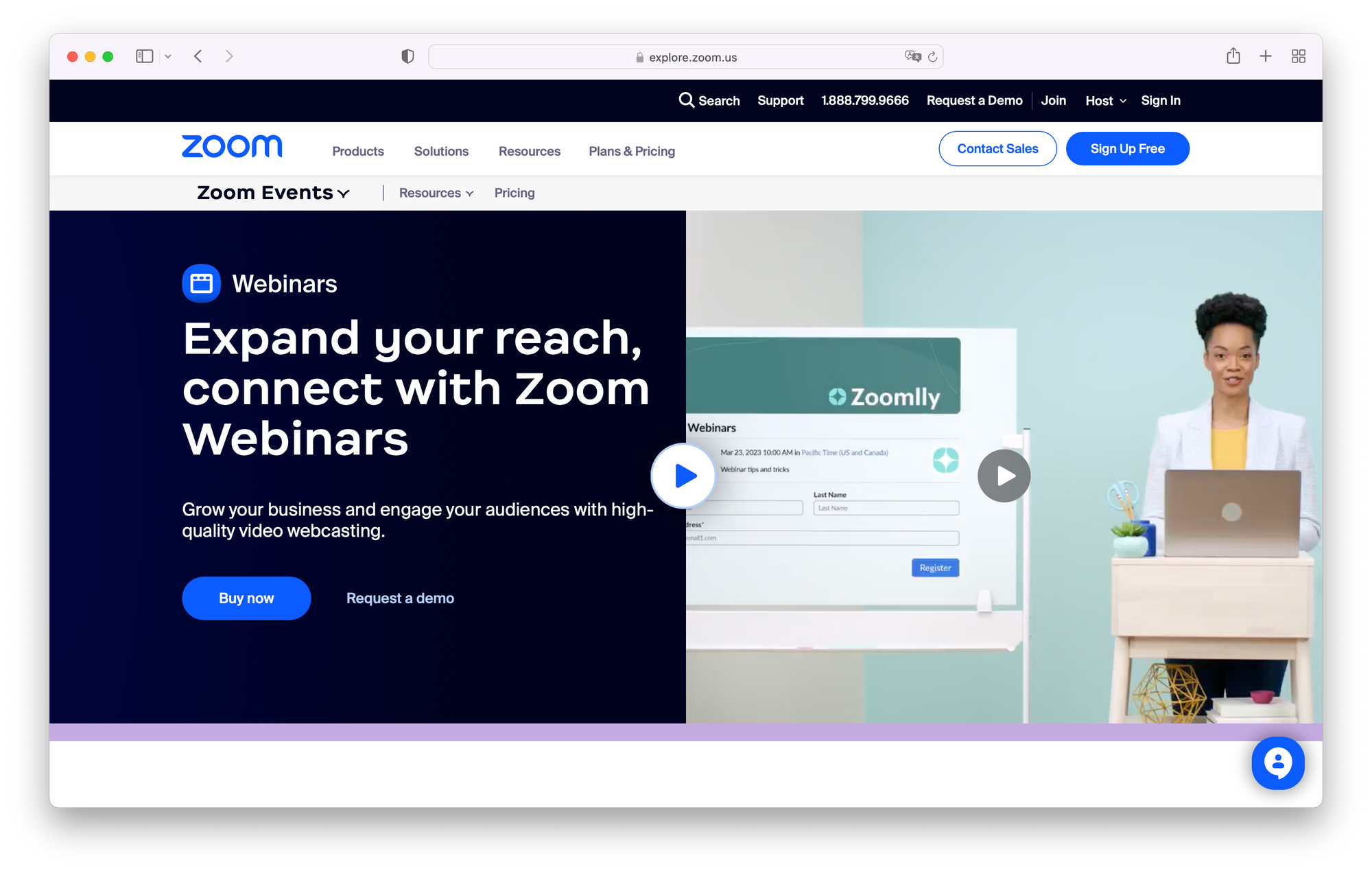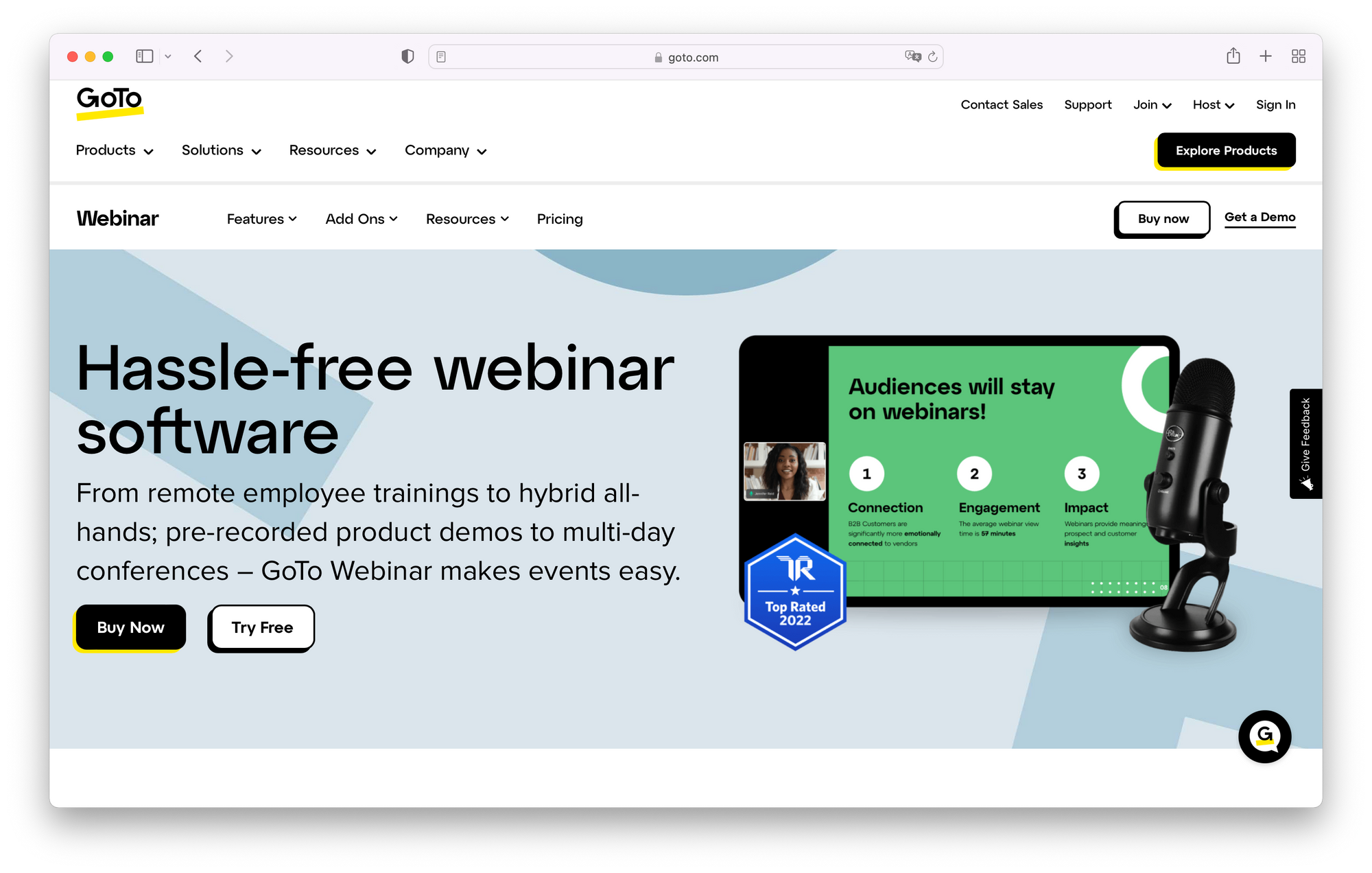Finding the best webinar platform for your business can be hard, especially when there are so many options to choose from.
If you’ve been looking at the different tools available to host your webinars, you’ve probably encountered tools such as Zoom Webinar and GoToWebinar.
Both platforms offer a basic coverage of the features you need to run webinars, no matter what your objective is. But how do they compare to one another in terms of offering, value, and pricing?
In this article we'll take a look at the key features and offering each platform has to offer. Let's jump right in.
How we sourced this data
To make sure we provide you with the best and most unbiased comparison possible, we look at 20+ websites.
These websites include user-review websites, specifically those specialized in SaaS, and the websites of the mentioned tools of course.
Information from these different sources were prioritized in the following order:
- Third party websites (no sponsored posts/content)
- User reviews (G2, Gartner, marketplaces)
- Websites of the tools themselves
Some examples of those relevant sources:
- Zoom reviews on G2
- Zoom reviews on Capterra
- GoToWebinar review on G2
- GoToWebinar reviews on TrustRadius
- GoToWebinar reviews on HubSpot Marketplace
Pricing, viewer limits, feature list, and customer support options are sourced directly on the website of the tools themselves.
We will try to provide the most unbiased review possible. However, the quality of the viewer experience for each tool is subjective. We will be judging it on the modernity and interactivity of the experience.
Before we get into the key features, here’s a brief overview of the two products, including Zoom Webinar vs GoToWebinar pricing and online review ratings.
Zoom Webinar overview

Cost
All Zoom Webinar plans require a Zoom One licence ($149.90/year/license) on top of the cost listed below
The cheapest plan for Zoom Webinars is is basically a large Zoom call. No custom branding, production tools, event hubs, backstage, or any of the features you're going to want to make your webinar stand out. This is the only plan that you can pay for monthly. They start at:
- $79 /month/licence for <500 attendees
- $340 /month/licence for <1000 attendees
- $990 /month/licence for <3000 attendees
- $2490 /month/licence for <5000 attendees
- $6490 /month/licence for <10000 attendees
But if you want to run branded sessions with event management, you're required to get an annual Zoom Webinar "Sessions" plan. These start at:
- $990 /year/licence for <100 attendees
- $3,490 /year/licence for <500 attendees
- $6,790 /year/licence for <1000 attendees
- $19,990 /year/licence for <3000 attendees
Pricing for larger plans is not available on their website.
Note that this pricing is per licence meaning that if you have multiple people in your team that need a Zoom account, you will most likely have to pay for multiple accounts.
P.S. Zoom also offers a "Zoom Events" plan, but this is geared towards virtual tradeshows rather than webinars or virtual events.
Free plan: Zoom Webinars does not offer a free plan.
Free trial: Zoom Webinars does not offer a free trial.
Reviews
Gartner reviews: 4.5/5 (347 ratings)
Ease of use: 9.1/10
Support: 8.6/10
Support options: Email and live chat (+ phone for Business/Enterprise)
Platform availability: Online, no download, all devices (mobile and desktop).
Zoom is probably the first tool that you think of when it comes to any kind of online video communication, and that's not surprising. They started as a video-conferencing tool and slowly made their way toward webinars, virtual events, tradeshows and more.
But its initial DNA as a video-conferencing tool and its sheer size today has impacted its ability to innovate and keep up with some of the trends we see in the webinar space today.
Users like the "comfort" of using a tool they've already used a million times for video calls, but when it comes to hosting and moderating a webinar the interface can be a little difficult to master. Prompting users to download (and/or open) software to be able to join is also a thing of the past. Turnout rates take a hit from this extra step in accessing the webinar.
Zoom's per license pricing model also makes it difficult to scale webinar efforts, multiplying the cost of the software by every new user you want to add to the team. Another trend we're seeing a lot of is unlimited team members.
The video conferencing-first design of Zoom also seems to negatively impact their capacity to integrate with the most common CRMs like HubSpot and Salesforce, which is an important piece of the puzzles for marketing teams doing lead gen with webinars for example.
Looking for an alternative? Check out our top 10 Zoom alternatives.
GoToWebinar overview

Cost
GoToWebinar has a very clear and cheap pricing model based on the number of live attendees to your events. However, they only have annual plans.
These start at:
- $588 /organizer/year for <250 live attendees
- $1188 /organizer/year for <500 live attendees
- $2388 /organizer/year for <1000 live attendees
- $4788 /organizer/year for <3000 live attendees
This may seem like one of the cheapest pricings of all the webinar tools, however note that it is based on the number of organizer seats, meaning that if you need to scale up your webinar efforts, it can get pricey, fast.
However, some key features only unlock on some of the more expensive plans, notably (with the respective yearly prices):
- Standard: $1188 /organizer/year
— Recording
— Channel pages - Pro: $2388 /organizer/year
— Integrations (HubSpot, Salesforce, etc.)
— Source tracking
— No download interface
— Video upload and presentation
Free plan: GoToWebinar does not offer a free plan.
Free trial: GoToWebinar offers a 7-day free trial. This is enough to run an internal test if you prepare everything well, but won't be enough to run a full-sized test event.
Reviews
Gartner reviews: 4.3/5 (252 ratings)
Ease of use: 8.8/10
Support: 8.2/10
Support options: Email or live chat.
Platform availability: Online, download (on some pricing plans), all devices (mobile and desktop).
GoToWebinar is a webinar platform that is part of the GoTo suite (along with GoToMeetings and GoToTraning). They were one of the first players to make it to the webinar market and build a recognizable brand for themselves in the industry.
They focus primarily on marketing and training/enablement use cases and have a basic set of functionalities.
They offer a cheap and reportedly easy-to-use platform for marketing and hosting webinars (even though "User interface" is their #1 con on G2). They provide interfaces to create basic landing pages quickly and interactivity features like Q&A and polls.
GoToWebinar's CRM integrations are lackluster - providing the basic requirements of an integration but lacking deeper features like compound reporting or reporting on replay views. This makes it harder for the webinar owner (or team) to report back to management on the efficiency of their efforts.
Their per-organizer pricing model also means that it can be complex to enable other teams than the core webinar team to run their own sessions.
Looking for an alternative? Check out our top 10 GoToWebinar alternatives.
Zoom Webinars vs. GoToWebinar Comparison
As you can see from the overview of Zoom Webinars and GoToWebinar, they offer very similar products and coverage of the basic features. This makes it difficult for users that are trying to figure out which solution best fits their needs.
Let's compare these two tools across 5 main topics:
- Live experience (host and speaker)
- Pre- and post-webinar experience
- Viewer experience
- Integrations
- Support
1. Live experience
As a host, the tool you choose is going to have a big impact on your capacity to put on a good show for your audience.
Most webinar tools offer a webinar studio to help you run more interactive webinars. Zoom has it's own version of that: an admin interface where you can create, edit, start polls, manage microphone and camera access, share screen, see live attendees and more.
Zoom's host and panelist experience is built off the meeting experience and isn't optimized for speakers and guests. It has a lot of options that can make accessing key parts of moderation complex (chat, participants, recording, Q&A, unmuting viewers, etc.).
There are different roles (Host, Co-host, Panelist) to manage permissions and only give access to the necessary features. This can come in handy by avoiding one of your panelists from stopping the webinar before it's over.

GoToWebinar also has it's own version of a "webinar studio" to host and animate your webinars. They offer the same features as Zoom but the interface is a little less user-friendly. They offer a lot of options and this can make the tool difficult to use, especially in a live context.

This interface is definetly not the most modern option of all the webinar platforms available on the market and can be daunting for people using it for the first time. But it gets the job done and covers all the main features.
Both tools offer similar speaker and moderator options to run your webinar, but GoToWebinar's complex (and a little out-dated) interface makes it a more difficult tool to use.
Winner: Zoom Webinars
2. Pre- and post-webinar experience
When it comes to your viewers' experience, Zoom Webinars and GoToWebinar are pretty evenly matched when it comes to the pre-and post-webinar experience, and both cover the basic features.
They both offer customizable and branded registration pages, automated reminder and follow-up emails, recurring sessions, automated webinars, and replays (Zoom Webinars and GoToWebinar do not record all webinars by default, so be careful if you go with them to run your events).
Zoom Webinar registration pages and emails give very few options in terms of customization and branding, even with the different template options. This can negatively impact conversion rates on your landing page, meaning fewer people sign up to your webinar.
GoToWebinar gives you a little bit more flexibility when it comes to emails and landing pages but the design is still basic and far from ideal.
But both tools allow you to build your own landing pages with 3rd party tools and send registrants to your webinars via automation tools.
As an organizer, however, Zoom Webinars users have reported that the interface as an organizer offers too many options and can get quite complex to set up and run a webinar strategy. GoToWebinar offers fewer (but better) options, streamlining the process.
Winner: GoToWebinar
3. Viewer experience
You've already been in a Zoom call. Well, the viewer experience of a Zoom Webinar is extremely similar to that of a call — maybe even indistinguishable.
Zoom Webinars gives you a few options to brand your webinar (depending on your pricing plan) with background images, logos, and more.
Polls, questions, and chat all have their own separate panels - making users to go back and forth to interact with them. This distracts users from your content, and reduces engagement on polls (because users might miss them).
The main issue with Zoom Webinars' viewer experience is that it's too familiar. It reminds users of a call and leaves them in a very different mindset from that of a webinar.

GoToWebinar's viewer experience looks a lot like its live experience for admins, moderators, and speakers. It's not great. Too many tabs, out-dated chat and complex settings make it a distracting experience for viewers and will have a negative impact on engagement.
No-download is the standard now when it comes to consuming content, and especially webinars. This is only available on Pro plans and above.
Both platforms support streaming your webinar in 720p.
Winner: Zoom Webinars
4. Integrations
Zoom Webinars integrates with Marketo, Pardot, Eloqua, HubSpot, Salesforce, and many other tools of the modern marketing stack. These integrations are available on all pricing plans making it a good choice for smaller teams with less budget. However, some users have reported that the CRM integrations do the "strict minimum" but far from what they would expect in terms of quality. Zoom Webinars also has an API allowing tech-heavy webinar teams a lot more flexibility when it comes to running and automating their webinar strategy.
GoToWebinar also has integrations with Marketo, Pardot, Eloqua, HubSpot, Salesforce and other major players. However, these are only available from the Pro plan and above (<1000 participants) so for smaller teams you might end up paying for a way bigger potential audience than you need. These integrations get average ratings across different marketplaces (3.8* on the HubSpot Marketplace)
Looking for the webinar tool with the best HubSpot integration?
Check out Contrast for free (4.9* on the HubSpot Marketplace).
Both Zoom Webinar and GoToWebinar offer Zapier integrations, allowing you to connect them to 3000+ tools. They both offer actions around the participant registering, attending a live, watching a replay. However, GoToWebinar offers triggers and actions around organizing webinars: create event, trigger on new event, etc. This makes it easier to automate the operations surrounding webinars.
Winner: GoToWebinar
5. Support
Both tools offer very similar support options: email and live chat.
Zoom Webinars and GoToWebinar both have a help center covering the most common issues that users run into. This makes it easier to onboard yourself onto the tool without needing help from an employee.
Users rate Zoom Webinar's support higher (8.6/10) than GoToWebinar, however this is substantially lower than many other tools on the market where you can easily get in touch with a human to help solve your problems.
None of the two platforms is a clear winner, but following users' reviews.
Winner: Zoom Webinar
Which is better — Zoom Webinars or GoToWebinar?
So we just took a look at each of these platforms, but which one is going to take first place?
GoToWebinar is going to be, on average, cheaper than Zoom Webinars if you're looking to run branded webinars (as Zoom requires you to get the "Sessions" plan). As discussed above, they also provide a more modern viewer experience, better integrations, and an overall better experience as a host and speaker.
However, if you have a smaller audience and require integrations like Hubspot, Salesforce, or source tracking, Zoom Webinars can be a cheaper option.
Go beyond webinars
Both Zoom Webinars and GoToWebinar are great tools for running your webinars.
However, there are many other alternatives to these two webinar tools offering a wide variety of features and pricing plans — and of course don't forget to take a look at Contrast.
Contrast is the most modern webinar tool on the market, covering all the basic features you're looking for in a tool while providing a fun, authentic and engaging experience to your audience.
We also offer tools to help you repurpose your webinar, a Netflix-like branded Channel to host all of your replays and upcoming events, all while providing the highest quality branded video experience on the market and stellar CRM integrations.

